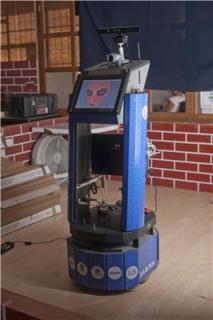Apr 2 2015
"A robot must obey the orders given to it by human beings except if they harm another person,” in order to turn the second law of robotics into a reality, Mexican Eduardo Morales Manzanares developed robots with artificial intelligence that don’t require specialized personnel to be controlled.

The Physics Engineer from the National Institute of Astrophysics, Optics and Electronics (INAOE) in Mexico, developed software that allows the robot named Sabina, to be able to learn with the guide of the user, either through a remote control or more naturally through voice commands or simply by showing the automaton tasks, as one would teach a toddler.
The quality of this unique instrument designed by fellow teacher in Information Technology from the University of Edinburgh in Scotland, is that anyone can program it without being an expert in robotics, since the purpose is to interact naturally with the robot and for it to recognize patterns of the environment as a room and walls to avoid colliding and learn autonomously to perform various tasks of daily life, including learning to go to certain places, bring the user’s favorite drink or some medicine.
The learning mechanism is independent to the robot. The idea, explains Morales Manzanares, is to have a program that acquires user information in order to use it in different robots and therefore is being tested on a mobile robot with wheels and a robotic arm, the software could even allow to teach a drone or helicopter to do reconnaissance flight over patrol zones or a certain region.
To do this, he adds, certain sensory capabilities are needed, interpretive programs to represent the observed and software to understand simple voice commands. To complement its learning, Sabina has laser sensors, a Xbox Kinect, which is an open technology that consists of a depth camera that captures 3D information, which allows to identify individuals and their position.
For example, the user can move its arm and the robot will replicate the movement, perceiving body language and thus learning to perform tasks, added the also PhD in Computer Science from the University of Strathclyde in the UK.
As for voice commands, they can be in Spanish or English, because the robot regularly participates in international competitions. Therefore, a larger vocabulary was designed for feedback to allow a more natural communication.
Based on the current state of the robot, it has a set of possible actions to take. It can select an action and get feed back from the environment or the user, who observes the automaton perform the task. This helps to improve the quality of its movements, as an exercise in trial and error in order to achieve choosing the actions that allow it to perform the task in the best way possible.
The coordinator of Computer Science at INAOE said that the initiative to create Sabina emerged from a basic science project at the National Council of Science and Technology (CONACYT) of Mexico, and eventually became the material evidence of the Markovito team, which participates in international tournaments of service robots .